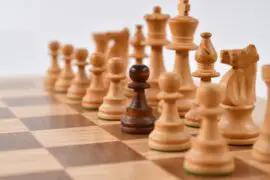This article deals with chess-related questions like ‘What is the 5 rules of chess’, why they are important to the game, and how they determine our chess moves. Read on for a detailed article about the five main rules that are integral to playing chess.
What Is the 5 Rules of Chess? Introduction
Contents
While most board games are aimed at fun and entertainment, chess is different. Chess is not just about having a good time, but it’s also a highly cognitive game that can be physically and mentally demanding. And yes, there are many rules to remember too. Chess teaches you how to be creative within certain boundaries, how to play under pressure and how to exert force under limitations.
If you want to excel at playing chess, then there are five most important rules of chess that dominate your moves. If you are not very familiar with these rules, you could lose a good game of chess even if you have a high IQ!
What is the 5 Rules of Chess? The Five Important Rules of Chess Explained
Rule 1: Pawn Promotion
The rule of pawn promotion is when one of your pawn pieces reaches the other side of the chess board or is in the eighth rank. Your pawns are like foot soldiers that are given a promotion to a higher official if they fare well on the battlefield. If one of your pawns manages to reach the other side of the chess board, they can be ‘promoted’ to one of the other chess pieces that are worth more points. For instance, you can exchange the pawn piece for a knight, bishop, rook or Queen.
There are two types of pawn promotion: Queening and Under Promotion. Queening is when you promote your pawn to a Queen, which is the most powerful piece on the chess board. So having two queens on the chess board is a good advantage. But Under Promotion is when you promote your pawn to a rook, bishop or knight that is less powerful than a Queen.

In pawn promotion, you can choose to promote your pawn to any other piece, with the exception of a King. You really cannot have more than one King on your side.
Pawn promotion is a rule in chess that really spices up the game toward the end. When a pawn is promoted, and you have more powerful pieces on your side, the real action begins.
Rule 2: Insufficient Material Draw
This is the rule that says that if a game cannot be ended in a checkmate, then it becomes a draw. This instance can happen when both sides only have a King. In a situation like this, it is impossible to create a checkmate. So then, when there are not enough chess pieces on either side, it is a draw.
Other situations where it results in a draw include; if there aren’t any pawns on either side but they have a king and a knight, a lone king or a king and a bishop.

Rule 3: En Passant
The rule of En Passant is pretty complicated for beginners in chess. Let me explain it to you.
‘En Passant’ literally means ‘in passing.’ Pawns can only capture pieces that are directly in front of them, diagonally or on an adjacent file to them in front. The pawn moves to the square of the captured piece and replaces it. This is the normal way a pawn captures, but with the en passant rule, things are different.
With the En Passant rule, the pawn will not land in the same place as the piece captured. To capture En Passant, you take the opponent’s pawn as if it has moved only one square. You move your pawn to the square that is adjacent to the captured pawn and simply take the enemy pawn off the board.
However, there are some requirements you should meet before capturing En Passant;
- The capturing pawn must have advanced exactly three ranks to be able to do this move.
- The captured pawn must have moved two squares in one move and landed right next to the capturing pawn.
- The capturing En Passant must happen immediately after the captured pawn moves. If you wait to capture it later on, then the rule is no longer applicable.
You cannot capture by En Passant if your pawn has moved more than three squares. You also cannot capture En Passant if the enemy pawn only lands next to your pawn after taking two moves instead of one.
Rule 4: Three-Fold Repetition
This is a rule that you will not be able to follow if you have not been writing down your opponent’s moves and yours. According to this rule, if one position happens in the game three times, then you can claim a draw.
The game would end due to this repletion because it signifies that there is no real progress in the game. This rule will not happen automatically. But one of the players can choose to claim the draw if they wish.

Rule 5: Fifty-Move Rule
The 50-move rule is a unique rule that prevents the chess game from falling into monotony. The rule says that if there hasn’t been any capture by either side in the last fifty moves, and any pawn pieces have not been moved during that period, then the player can claim a draw.
This rule indicates 50 rules for each player, so a total of 100 moves in all. The simple reason behind this is to prevent a game of chess from going on forever. Here too, the game will not automatically become a draw. The draw has to be requested by one of the players.
What is the 5 Rules of Chess? Conclusion
There are any rules to a game of chess than five. And all of them are important if you are to play chess correctly. It’s important to learn all about the rules of chess, why they exist and why it is important to you if you want to be good at playing chess. Other rules of chess include the touch-move rule, the stalemate rule, castling and the new 75-move rule.
If you are a beginner in chess, here is a complete guide of all the chess rules to get you started.
*All pics are taken from Unsplash.com




